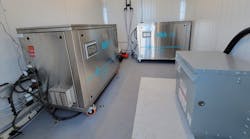SANTA CLARITA, Calif., March 27, 2003 -- Ordinances prohibiting Santa Clarita Valley residents from installing self-regenerating water softeners, including new and replacement units, went into effect Thursday, announced the Sanitation Districts of Los Angeles County.
The ordinances, which were unanimously approved by the Boards of Directors for Sanitation Districts Nos. 26 and 32 last month, aim to reduce the amount of chloride going into the Santa Clara River. Residential self-regenerating water softeners are among the leading causes for high chloride levels in the river. The number of residential self-regenerating water softeners has been rapidly increasing in the Santa Clarita Valley, with the percentage of residences having such softeners increasing from approximately 11% in 2001 to 13% in 2002.
The new ordinances prohibit the installation of residential self-regenerating water softeners, also known as automatic water softeners, after March 27. The ordinances do not apply to water softeners using exchange tanks, as these are regenerated at a centralized location outside of the Santa Clarita Valley.
The ordinances also do not apply to other types of water treatment units such as filtration, activated carbon, and reverse osmosis. Homeowners who already have self-regenerating water softeners are also not immediately affected by the ordinances, which prohibit installation rather than ownership. However, homeowners will not be permitted to replace their existing self-regenerating water softeners and are strongly encouraged by the Sanitation Districts to stop using the existing units to help reduce chloride levels in the river.
Chloride is one of the two parts of sodium chloride, commonly known as salt, and of potassium chloride. Self-regenerating water softeners discharge a waste that contains large amounts of chloride. Wastewater from homes in the Santa Clarita Valley, including the softener waste, is treated at the Sanitation Districts' Saugus and Valencia Water Reclamation Plants. After extensive treatment, which does not remove chloride from wastewater, the treated water is put into the Santa Clara River. The amount of chloride in the river has been steadily rising over the years as more self-regenerating water softeners were installed into homes.
"Virtually all of the chloride put into self-regenerating water softeners as rock salt or potassium crystals ends up in the Santa Clara River," says Ann Heil, senior engineer for the Sanitation Districts' Industrial Waste Section. "Using a self-regenerating softener for a month is basically the same as taking a 40-pound bag of salt and dumping it directly into the river."
If the amount of chloride entering sewers in the Santa Clarita Valley is not reduced, the Sanitation Districts may have to install costly new treatment equipment at the Saugus and Valencia Water Reclamation Plants to remove the chloride. These costs would be passed on to residences and businesses, and could increase their sewer bills by four to five times the current rate, or $400 to $500 per year.
Alternatively, if treatment has to be provided at the plants, the Sanitation Districts may consider a tiered rate program, wherein only those households with self-regenerating water softeners would be charged higher sewer rates to pay for the cost of removing the salt waste discharged by the softeners. In this case, households with self-regenerating water softeners could be charged up to two thousand dollars per year for sewerage services, while sewer rates would remain steady for other households.
"Banning future installation of self-regenerating water softeners is the most cost-efficient way to lower chloride levels and will help us avoid installing this very expensive treatment alternative at Santa Clarita ratepayer's expense," Heil says.
Residents who violate the new ordinances are subject to a fine of up to $1,000 and/or imprisonment not to exceed 30 days. Only residences served by Sanitation Districts Nos. 26 and 32, which provide for the wastewater treatment and disposal needs of the Santa Clarita Valley, are affected by the ordinances. (Those homes that use septic tanks are not affected by the new ordinances.) Santa Clarita businesses have been banned from using self-regenerating water softeners since 1961.
The Sanitation Districts are a group of 25 independent special districts serving the wastewater and solid waste management needs of over 5 million people in Los Angeles County. The Sanitation Districts serve 78 cities and unincorporated territory within the county, and the service area includes the Santa Clarita Valley. The role of the Sanitation Districts is to construct, operate, and maintain regional systems to collect, treat, and dispose of wastewater and to provide for management of solid wastes. The Directors of the districts are the mayors of the cities within a district and the Chairperson of the County Board of Supervisors for unincorporated areas.

